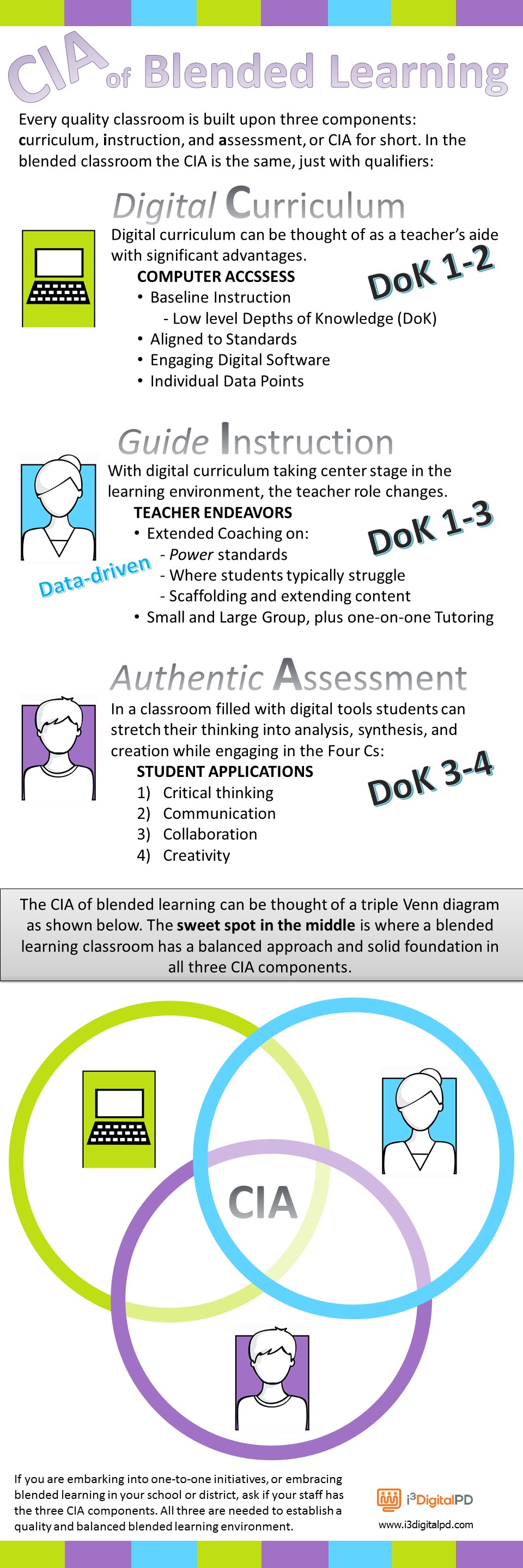Every quality classroom is built upon three components – curriculum, instruction, and assessment, or CIA for short. In a digital learning world the CIA is the same, just with qualifiers:
- Digital Curriculum
- Guided Instruction
- Authentic Assessment
Digital Curriculum
Digital curriculum typically comes in the form of software or open education resources (OER). It is a rare situation when a teacher can create their own digital curriculum that has all the components of an effective lesson, from an opening hook, review of previous knowledge, delivery of new content, real-world application, and a summative close. along with tasks for students to demonstrate understanding (e.g., assignments and assessments). Typically, a teacher gathers pre-made resources from others, via the web or from publishers, to ‘deliver’ lessons; rarely are they actually ‘developing’ lessons from scratch. Teachers are good at curating OER materials, which takes time. The handful of teachers who have ‘flipped’ their classroom by creating video lessons will tell you that digital content development is time-consuming, and most schools only provide a very small preparation period for teacher planning (not developing). Thus, high-quality software and applications that can aid in the delivery of digital content are needed.
Digital curriculum can be thought of as a teacher’s aide with significant advantages:
- Engages student attention and delivers content
- Provides data with insight into student strengths and weaknesses
- Has no limits as to when or where it can be accessed
- It is ideal for presenting and assessing student understanding and practicing skills
Guided Instruction
One thing a digital curriculum can not do is establish a relationship with students. That’s why teachers will always remain the strength of the classroom, with a heart that touches and cares for each and every student.
With digital curriculum taking center stage in the learning environment, the teacher’s role changes to one relying on relationships, human analysis, and intervention. Students respond to the human interaction, the caring heart, and the smiling teacher in the classroom. Thus, the teaching staff, using their expertise in educational theory to analyze the digital data and identify strengths and weaknesses with the digital curriculum, can create a learning environment that complements and extends student learning to higher-level analysis and synthesis.
Guided instruction may include:
- Whole group learning
- Student-centered frameworks such as playlists and choice boards/menus
- One-on-one or small group tutoring intervention
- Hands-on activities/investigations
- Class discussions or Socratic seminars
The human touch is important in every classroom. Technology can never replace human relationships between students and their teachers.
Authentic Assessment
Authentic assessment is a must in a classroom filled with digital tools and curriculum, access to the web, and teachers who push students to expand their learning. Digital curriculum relies heavily on recall and understanding. Guided instruction asks students to stretch into analysis and synthesis. Authentic assessments must challenge students to think critically and push them to deeper depths of knowledge.
Authentic assessments should include:
- Active engagement
- Peer-to-peer interactions and collaborations
- The Four Cs: 1) Collaborate, 2) Communicate, 3) Critical thinking, and 4) Creativity
- Projects and presentations
This is a time to allow students to demonstrate learning in fun and creative ways while building durable skills such as time management, teamwork, and leadership.
If you are embracing blended learning in your school or district, ask if your staff has the three CIA components of digital learning:
- Digital Curriculum
- Guided Instruction
- Authentic Assessment
All three are needed to establish a high-quality, balanced blended learning environment.
Share your thoughts on social media with #CIAofBlanded.


